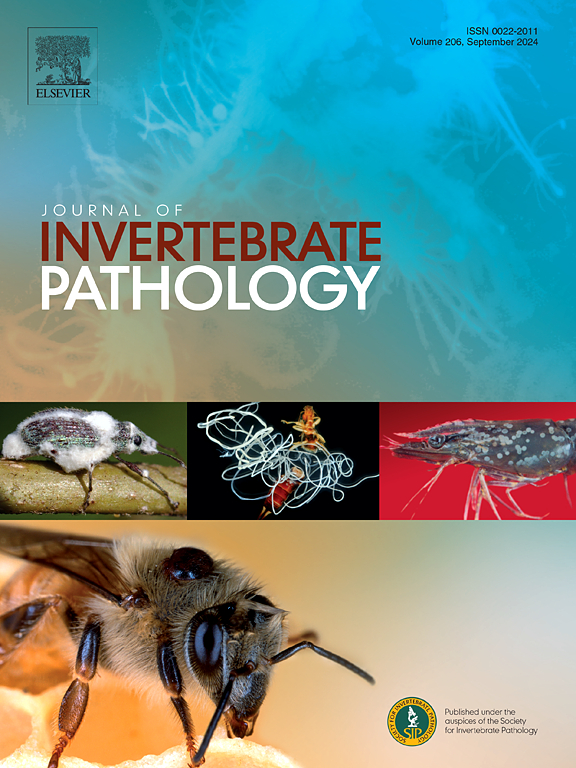Characterization of Enterocytozoon hepatopenaei infection stages in shrimp using machine learning and gene network analysis
IF 2.4
3区 生物学
Q1 ZOOLOGY
引用次数: 0
Abstract
Enterocytozoon hepatopenaei (EHP), causing hepatopancreatic microsporidiosis (HPM), significantly impacts Litopenaeus vannamei, leading to economic losses. Using bioinformatics and machine learning, this study characterized EHP infection stages and host-pathogen interactions. Consensus clustering of 2,613 metabolism-related genes from 36 shrimp samples identified four subclasses: healthy (HG), heavily (HEG), moderately (MEG), and lightly infected groups (LEG). Gene Set Variation Analysis (GSVA) revealed subclass-specific metabolic and immune patterns, with HEG showing impaired carbohydrate metabolism and upregulated amino acid degradation, MEG indicating recovery, and LEG demonstrating metabolic normalization. Weighted Gene Co-expression Network Analysis (WGCNA) linked infection subclasses to pathways like Hippo, JAK-STAT, steroid biosynthesis, and calcium signaling. Machine learning identified 52 characteristic genes involved in EHP proliferation (e.g., RAPTOR), host invasion (e.g., cell surface glycoprotein 1), and host defense (e.g., mucin-5AC). A stacked classifier model predicted infection severity with high accuracy. EHP severely impacts immunity, autophagy, and oxidative stress in early infection, with host responses evolving from detoxification to metabolic recovery and adaptation. Key pathways and genes, including polar tube protein (PTP) and mucin-5AC, were identified as critical to host-pathogen interactions, offering insights into EHP infection dynamics and potential intervention strategies.

利用机器学习和基因网络分析表征对虾肝芽胞虫感染阶段
肝叔肠胞虫(EHP)引起肝胰腺微孢子虫病(HPM),严重影响凡纳滨对虾,造成经济损失。利用生物信息学和机器学习,本研究表征了EHP感染阶段和宿主-病原体相互作用。对来自36个虾样本的2613个代谢相关基因的一致聚类鉴定出四个亚类:健康(HG)、重度(HEG)、中度(MEG)和轻度感染组(LEG)。基因集变异分析(GSVA)揭示了亚类特异性代谢和免疫模式,HEG显示碳水化合物代谢受损,氨基酸降解上调,MEG显示恢复,LEG显示代谢正常化。加权基因共表达网络分析(WGCNA)将感染亚类与Hippo、JAK-STAT、类固醇生物合成和钙信号通路联系起来。机器学习鉴定了52个与EHP增殖(如RAPTOR)、宿主入侵(如细胞表面糖蛋白1)和宿主防御(如mucin-5AC)有关的特征基因。采用堆叠分类器模型预测感染严重程度,准确率较高。EHP在感染早期严重影响免疫、自噬和氧化应激,宿主反应从解毒到代谢恢复和适应。包括极管蛋白(PTP)和粘蛋白- 5ac在内的关键途径和基因被确定为宿主-病原体相互作用的关键,为EHP感染动力学和潜在的干预策略提供了见解。
本文章由计算机程序翻译,如有差异,请以英文原文为准。
求助全文
约1分钟内获得全文
求助全文
来源期刊
CiteScore
6.10
自引率
5.90%
发文量
94
审稿时长
1 months
期刊介绍:
The Journal of Invertebrate Pathology presents original research articles and notes on the induction and pathogenesis of diseases of invertebrates, including the suppression of diseases in beneficial species, and the use of diseases in controlling undesirable species. In addition, the journal publishes the results of physiological, morphological, genetic, immunological and ecological studies as related to the etiologic agents of diseases of invertebrates.
The Journal of Invertebrate Pathology is the adopted journal of the Society for Invertebrate Pathology, and is available to SIP members at a special reduced price.

 求助内容:
求助内容: 应助结果提醒方式:
应助结果提醒方式:


